By Renu Jain Chandarana
Growing up, there was no other food in my life that was as comforting as kitchari. Wait. What? Did I just say that? Let me rephrase. There was no other HEALTHY food in my life that was as comforting as kitchari. Phew, that’s better. (Sorry french fries, ice cream and chocolate chip cookies…I will always love you!)

Renu Jain Chandarana, Writer
Since we’re talking healthy and comforting I need to mention to those unfamiliar with it, that it is the go to Indian dish for when you are not feeling well, when you are in a pinch to make something fast for your family, and when you have nothing of substance in your fridge or pantry. It’s high in protein, warms you up by sticking to your insides on a cold day, and as this recipes shows, can be a great way to get some vegetables into your kids. (They virtually disappear into it.)
This leads me to why I call this recipe my “kitchen sink kitchari,” because I really do put anything but the kitchen sink into it. You can use any lentil of your choice – preferably one that is split (red lentil, yellow moong, or split green moong). Typically, vegetables are not a traditional addition to kitchari (at least not in my house when I was growing up) but once I had kids, it was sort of a no brainer to just add them and turn the dish into a one-pot meal.
Some of my favorite vegetables to add are sweet potatoes (into the pot before cooking) and sweet green peas (stirred in after the kitchari is cooked so that they add a burst of sweetness). I have also jumped on the quinoa bandwagon and try to replace half of my rice with half quinoa. My kids don’t even notice it. Chia seeds add Omega 3 fatty acids, calcium, fibre, protein and a little texture.
I have two favorite ways of eating this meal. The first is the way I ate it growing up, with pappard (poppadums), yogurt and achar (mango or lime pickle). The second way of serving it, I discovered after I got married – the Gujarati way with a mildly sweet kadhi poured on top. Sometimes, it’s the simple foods in our lives that give us the greatest pleasure.
Kitchen Sink Kitchari: 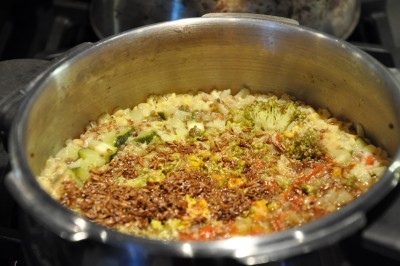
½ cup daal of your choice (I used yellow moong daal)
½ cup long grain rice
¼ cup quinoa
2 Tbsps. chia seeds
2 cups water (give or take, depending on how thin/thick you like your kitchari)
1-2 inches of fresh ginger
1 cup of mixed vegetables of your choice, chopped finely (I used: carrots, zucchini, tomato, and broccoli)
Masala Mix (a.k.a Thadka or Chownk) 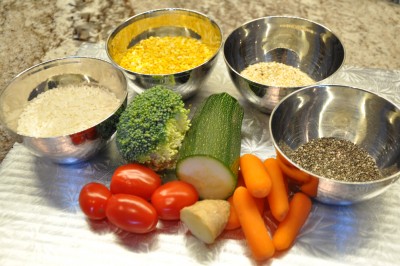
2 Tbsps. Ghee (or butter or any oil you prefer)
2 tsps. Jeera (cumin)
½ tsp Ground Dhania (ground coriander seed)
½ tsp Garam Masala
¼ tsp Haldi (turmeric)
¼ tsp salt (add more or omit as you wish)
Pinch (or a few shakes from the bottle) Hing (Asafetida)
Directions:
Mix the daal, rice, quinoa, and chia seeds together and rinse with water thoroughly until the water rinses clear. Cover with water and let soak for 20 minutes. In the mean time, chop the vegetables that you’ll be adding to the kitchari. Be sure to chop them into really small pieces.
Drain the soaking mixed lentils, grains and seeds and pour into a medium sized pressure cooker or into a medium to large sized pot. Cover with 2 cups of water and all the veggies you’d like to add. Make sure you have a pot big enough to fit everything!
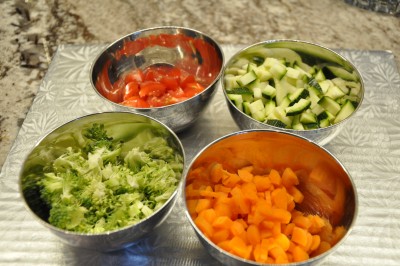
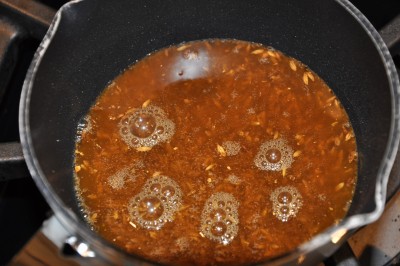
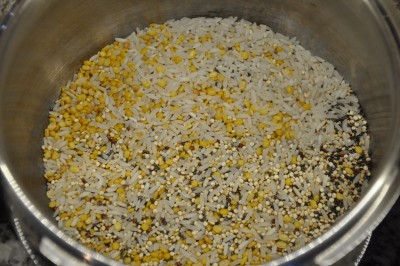
Pressure Cooker Method (15 minutes):
If using a pressure cooker, make sure the lid is sealed on tight and the whistle is on. Cook on medium or medium/low for about 15 minutes – usually two whistles is enough. After two whistles, or about 15 minutes, turn the stove off and let the kitchari cook in the residual heat that’s inside the pressure cooker.
**Pressure cookers will vary so if two whistles is not enough for you, then you might have to turn the stove off, take the cooker off the stove and run it under cold water in the sink in order to open it safely and check on the kitchari inside. You might even need to add more water if you feel like it’s too thick or the daal, rice, and quinoa are undercooked but the liquid inside is gone. Put it back on the stove for another whistle if that’s the case. You can’t over cook kitchari, but you can definitely undercook it!
Regular Pot Method (takes anywhere from 20-30 minutes depending on the lentils used):
If cooking with a pot, place the lid on slightly at an angle to let some steam escape. Place on the stove on medium to medium/low heat. You want to bring the kitchari to a rolling boil and then keep it at a simmer. I would keep an eye on the pot every 5-10 minutes once it has reached the rolling boil stage and turn the heat down notch to keep it at a simmer. Stir the kitchari to make sure nothing is sticking to the bottom of the pot. You want to cook it down until everything in the pot gets soft and porridgey, this might mean adding more water if you feel like it’s getting thick, or if the daal, rice, and quinoa are undercooked. Did I mention that you can’t over cook kitchari, but you can definitely undercook it!
Once the kitchari is cooked, take your fresh ginger and finely grate it in using a microplane or the small grate on your grater.
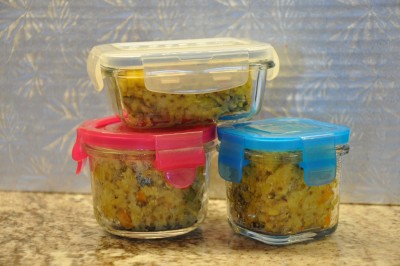
Kitchari
To make the masala mix (a.k.a. thadka or chownk), melt the ghee in a small fry pan or small pot. Once it’s heated (but not smoky) add the spices and roast in the ghee for a few minutes. You don’t want the masala mixture to be too brown, so take it off the heat if you think it’s getting smoky or a little dark in colour. Sorry to say, but you’ll have to start over if you think you burned it. The burned flavour will permeate the whole batch of kitchari and you don’t want that! You want a medium brown roast on the masalas. Pour the whole toasted mixture over the kitchari – you should hear the Masala mix sizzle and sing once it hits the hot kitchari! Stir it in vigorously. Add more water if necessary to the kitchari if you feel like it’s too thick. If you’ve made it too thin – let it cool, it will thicken up as it cools.
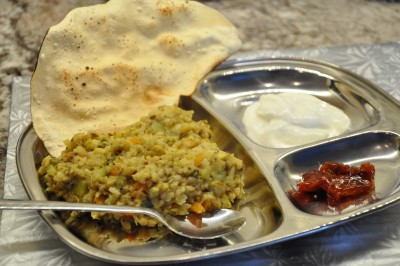
Serve with sides of your choice:
Plain Yogurt
Raita (Spiced Yogurt with roasted jeera, dried mint and black salt)
Pappard (Poppadums)
Achar (mango or lime pickle)
ENJOY as it warms your insides as much as it nourishes!
Note: this freezes really well, so if you are making it for your kids, you can dish it out into smaller containers and load up the freezer. I wouldn’t keep it in the freezer for more than 2 weeks (it gets a bit watery once defrosted).
What are some ways that you have enjoyed your kitchari?



One of my favourite foods! I often add veggies but now will try it with chia and quinoa too. Thanks for sharing Renu.